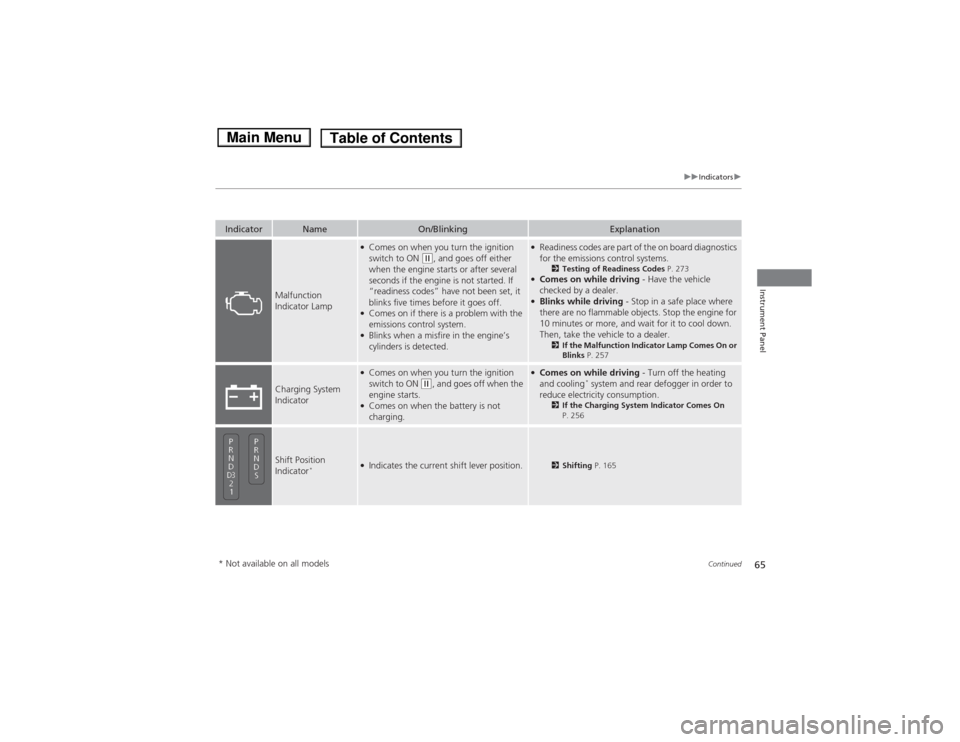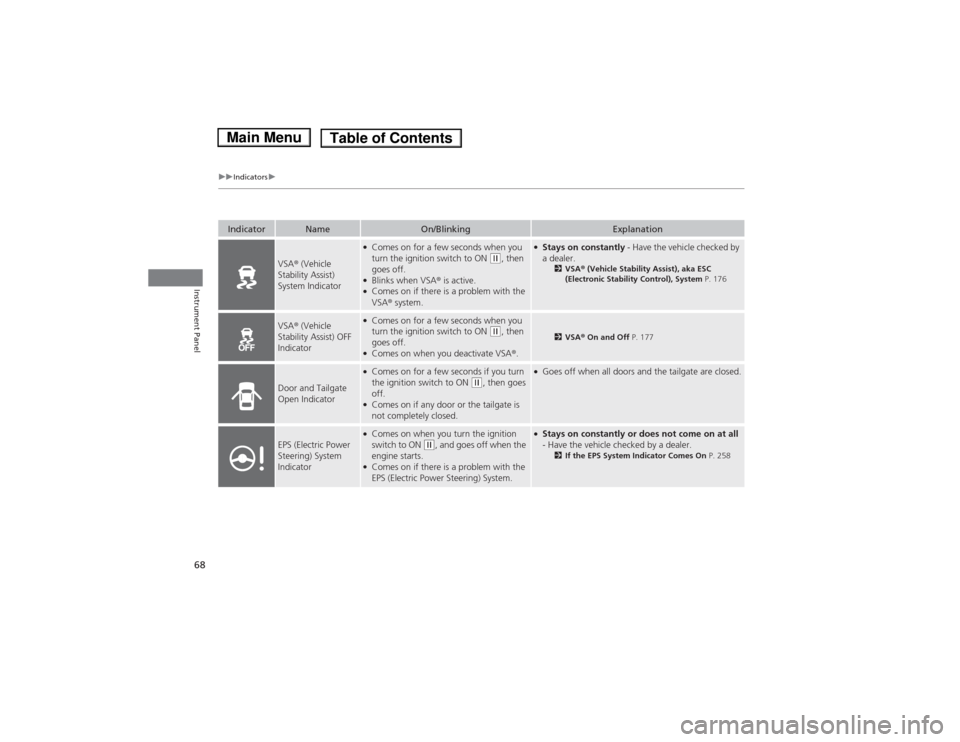Page 2 of 289

Contents
Child Safety P. 49 Exhaust Gas Hazard P. 61 Safety Labels P. 62Opening and Closing the Tailgate P. 88 Security System P. 90
Operating the Switches Around the Steering Wheel P. 94 Adjusting the Mirrors P. 102
Interior Lights/Interior Convenience Items P. 111 Heating and Cooling
* P. 118
Audio Error Messages P. 135 General Information on the Audio System P. 137When Driving P. 161 Braking P. 181 Parking Your Vehicle P. 185
Accessories and Modifications P. 190Maintenance Under the Hood P. 199 Replacing Light Bulbs P. 212
Checking and Maintaining Tires P. 222 Battery P. 231 Remote Transmitter Care
* P. 232
Cleaning P. 234
Engine Does Not Start P. 250 Jump Starting P. 251 Shift Lever Does Not Move P. 253
Fuses P. 260 Emergency Towing P. 264 Devices that Emit Radio Waves P. 271 Reporting Safety Defects P. 272
Authorized Manuals P. 277 Customer Service Information P. 278
Quick Reference Guide
P. 2
Safe Driving
P. 21
Instrument Panel
P. 63
Controls
P. 75
Features
P. 121
Driving
P. 153
Maintenance
P. 191
Handling the Unexpected
P. 237
Information
P. 267
Index
P. 279
Page 8 of 289
7Quick Reference Guide
Safe Driving
(P 21)
Airbags
(P34)
●Your vehicle is fitted with airbags to help protect you and
your passengers during a moderate-to-severe collision.
Child Safety
(P49)
●All children 12 and younger should be seated in the rear seat.
●Smaller children should be properly restrained in a forward-facing child seat.
●Infants must be properly restrained in a rear-facing child seat.
Exhaust Gas Hazard
(P61)
●Your vehicle emits dangerous exhaust gases that contain
carbon monoxide. Do not run the engine in confined spaces
where carbon monoxide gas can accumulate.
Before Driving Checklist
(P154)
●Before driving, check that the front seats, head restraints,
steering wheel, and mirrors have been properly adjusted.
Seat Belts
(P26)
●Fasten your seat belt and sit upright well
back in the seat.
●Check that your passengers are wearing
their seat belts correctly.
Fasten your lap belt as
low as possible.* Not available on all models
Page 16 of 289
15Quick Reference Guide
Maintenance
(P191)
Under the Hood
(P199)
●Check engine oil, engine coolant, and windshield washer
fluid. Add when necessary.
●Check brake fluid and clutch fluid.
●Check the battery condition monthly.
a
Pull the hood release handle under the corner of the
dashboard.
b
Locate the hood latch lever, pull the lever up, and lift up
the hood.
c
When finished, close the hood and make sure it is firmly
locked in place.
Lights
(P212)
●Inspect all lights regularly.
Wiper Blades
(P218)
●Replace blades if they leave streaks
across the windshield.
Tires
(P222)
●Inspect tires and wheels regularly.
●Check tire pressures regularly.
●Install snow tires for winter
driving.
* Not available on all models
Page 17 of 289
16Quick Reference Guide
Handling the Unexpected
(P237)
Flat Tire
(P239)
●Park in a safe location and repair the flat
tire with the compact spare tire
*, or using
the tire repair kit
* in the cargo area.
Indicators Come On (P256)
●Identify the indicator and consult the
owner’s manual.
Engine Won’t Start
(P250)
●If the battery is dead, jump start using a
booster battery.
Blown Fuse
(P260)
●Check for a blown fuse if an electrical
device does not operate.
Overheating
(P254)
●Park in a safe location. If you do not see
steam under the hood, open the hood,
and let the engine cool down.
Emergency Towing
(P264)
●Call a professional towing service if you
need to tow your vehicle.
Page 65 of 289

64Instrument Panel
IndicatorsIndicator
Name
On/Blinking
Explanation
Parking Brake and
Brake System
Indicator
●Comes on for a few seconds when you
turn the ignition switch to ON
(w, then
goes off.
●Comes on when the parking brake is
applied, and goes off when it is released.●Comes on when the brake fluid level is
low.●Comes on if there is a problem with the
brake system.●The beeper sounds and the indicator
comes on if you drive with the parking
brake not fully released.
●Comes on while driving - Make sure the parking
brake is released. Check the brake fluid level.
2What to do when the indicator comes on while
driving P. 258
●Comes on along with the ABS indicator - Have
the vehicle checked by a dealer.
2If the Brake System Indicator Comes On P. 258
Low Oil Pressure
Indicator
●Comes on when you turn the ignition
switch to ON
(w, and goes off when the
engine starts.
●Comes on when the engine oil pressure
is low.
●Comes on while driving - Immediately stop in a
safe place.
2If the Low Oil Pressure Indicator Comes On
P. 256
U.S.Canada
Page 66 of 289

65
uuIndicatorsu
Continued
Instrument Panel
Indicator
Name
On/Blinking
Explanation
Malfunction
Indicator Lamp
●Comes on when you turn the ignition
switch to ON
(w, and goes off either
when the engine starts or after several
seconds if the engine is not started. If
“readiness codes” have not been set, it
blinks five times before it goes off.
●Comes on if there is a problem with the
emissions control system.●Blinks when a misfire in the engine’s
cylinders is detected.
●Readiness codes are part of the on board diagnostics
for the emissions control systems.
2Testing of Readiness Codes P. 273
●Comes on while driving - Have the vehicle
checked by a dealer.●Blinks while driving - Stop in a safe place where
there are no flammable objects. Stop the engine for
10 minutes or more, and wait for it to cool down.
Then, take the vehicle to a dealer.
2If the Malfunction Indicator Lamp Comes On or
Blinks P. 257
Charging System
Indicator
●Comes on when you turn the ignition
switch to ON
(w, and goes off when the
engine starts.
●Comes on when the battery is not
charging.
●Comes on while driving - Turn off the heating
and cooling
* system and rear defogger in order to
reduce electricity consumption.
2If the Charging System Indicator Comes On
P. 256
Shift Position
Indicator
*
●Indicates the current shift lever position.
2Shifting P. 165
* Not available on all models
Page 68 of 289

67
uuIndicatorsu
Continued
Instrument Panel
Indicator
Name
On/Blinking
Explanation
ABS (Anti-lock
Brake System)
Indicator
●Comes on for a few seconds when you
turn the ignition switch to ON
(w, then
goes off.
●If it comes on at any other time, there is
a problem with the ABS.
●Stays on constantly - Have the vehicle checked by
a dealer. With this indicator on, your vehicle still has
normal braking ability but no anti-lock function.
2ABS (Anti-lock Brake System) P. 183
Supplemental
Restraint System
Indicator
●Comes on for a few seconds when you
turn the ignition switch to ON
(w, then
goes off.
●Comes on if a problem with any of the
following is detected:
-Supplemental restraint system
-Side airbag system
-Side curtain airbag system
-Seat belt tensioner
●Stays on constantly or does not come on at all
- Have the vehicle checked by a dealer.
High Temperature
Indicator
●Comes on for a few seconds when you
turn the ignition switch to ON
(w, then
goes off.
●Blinks when the engine coolant
temperature goes up, and stays on if the
temperature continues to rise.
●Blinks while driving - Drive slowly to prevent
overheating.●Stays on while driving - Immediately stop in a
safe place and allow the engine to cool.
2Overheating P. 254
Low Temperature
Indicator
●Comes on for a few seconds when you
turn the ignition switch to ON
(w.
●Comes on when the engine coolant
temperature is low.
●If the indicator stays on after the engine has reached
normal operating temperature, there may be a
problem with the temperature sensors. Have the
vehicle inspected by a dealer.
Page 69 of 289

68
uuIndicatorsu
Instrument Panel
Indicator
Name
On/Blinking
Explanation
VSA® (Vehicle
Stability Assist)
System Indicator
●Comes on for a few seconds when you
turn the ignition switch to ON
(w, then
goes off.
●Blinks when VSA® is active.●Comes on if there is a problem with the
VSA® system.
●Stays on constantly - Have the vehicle checked by
a dealer.
2VSA® (Vehicle Stability Assist), aka ESC
(Electronic Stability Control), System P. 176
VSA® (Vehicle
Stability Assist) OFF
Indicator
●Comes on for a few seconds when you
turn the ignition switch to ON
(w, then
goes off.
●Comes on when you deactivate VSA®.
2VSA® On and Off P. 177
Door and Tailgate
Open Indicator
●Comes on for a few seconds if you turn
the ignition switch to ON
(w, then goes
off.
●Comes on if any door or the tailgate is
not completely closed.
●Goes off when all doors and the tailgate are closed.
EPS (Electric Power
Steering) System
Indicator
●Comes on when you turn the ignition
switch to ON
(w, and goes off when the
engine starts.
●Comes on if there is a problem with the
EPS (Electric Power Steering) System.
●Stays on constantly or does not come on at all
- Have the vehicle checked by a dealer.
2If the EPS System Indicator Comes On P. 258